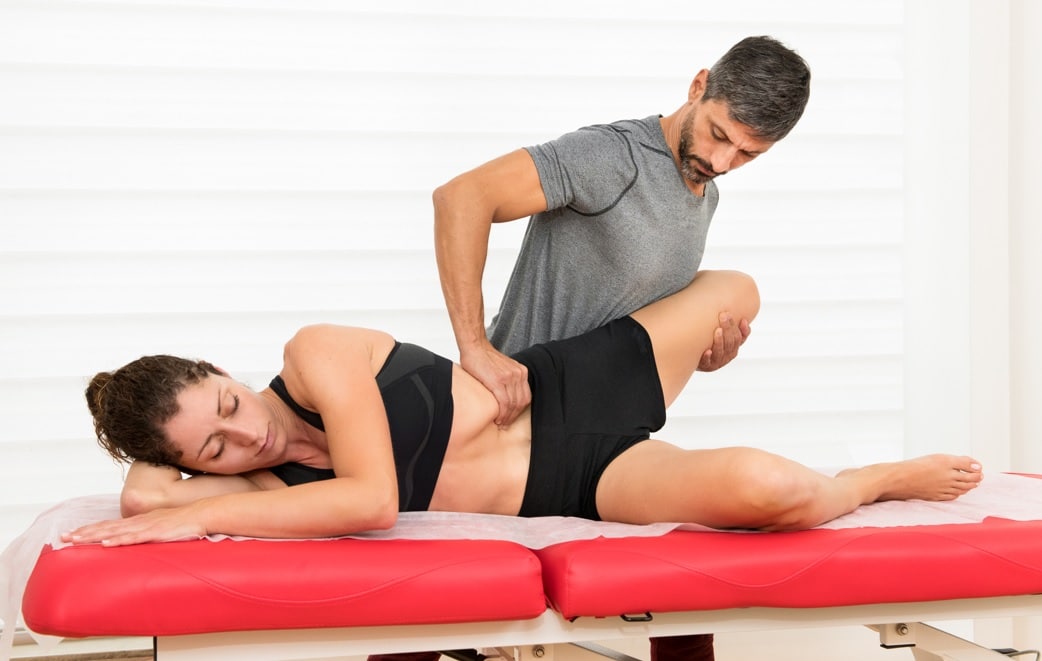Hip flexors are a group of muscles that allow you to move your legs when you walk, run or bend forward. Pain in the area can occur because of an injury or strain due to strenuous activity or overuse and can interfere with your daily life without proper treatment.
What is a hip flexor?
Hip flexors are a group of muscles that connect the lower back, pelvis, hips, groin and thighs. They run along the front of your upper thigh and work together to produce flexion, the movement and tightening of muscles that make your hip joint flexible. These muscles stretch and press together to allow your body to move, stabilize your spine and help when you extend your leg at the knee.
What causes hip flexor pain?
Pain in the hip flexors occurs when the muscles and tendons are overused or pulled beyond their limits from sudden movements like kicking or sprinting. Tight hip flexors are usually caused by not properly warming up before physical activities or not exercising at all. A strain is a type of tear in the muscle tissue.
Trauma, such as a fall or car accident, can cause pain and injury from tensing up the muscles as a way of bracing for impact.
Runners, martial artists and cyclists are more likely to develop this type of strain because of continuous kicking movements that engage the quadriceps. Football, soccer and hockey players can strain the muscles in that area because of sudden movements when changing direction.
People who have sedentary lifestyles or work at a desk for long periods can develop tight hip flexors, leading to strain or injury. Poor posture can also contribute to hip flexor pain. Alignment issues in the hips or legs can cause pain in the area because of excessive pressure on one side of the body.
What are the symptoms of a hip flexor injury?
Symptoms of a strain or injury to the hip flexors can vary depending on the area and the extent of the damage. They can range from mild pain to a sharp ache. Hip flexor strain can make walking difficult because of tightness and pain in the thigh. Other symptoms include:
- Pain when walking or running
- Increasing pain when you bend your leg toward your chest
- Muscle spasms or cramping
- Tenderness in the hips, groin or thigh
- Pain when stretching the thigh or hip muscles
- Muscle tightness after a period of rest
- Swelling or bruising at the pain site
Hip flexor strains caused by tears in the muscles are categorized by a physician based on the severity of the tearing. Most strains are classified as grade two.
- Grade 1 is a minor tear with only a few damaged muscle fibers.
- Grade 2 is a moderate tear of multiple muscle fibers that can lead to loss of mobility.
- Grade 3 is a severe tear that causes difficulty walking without a limp.
What treatments are available for hip flexor pain?
Hip flexor pain can be treated with home remedies and physical therapy to decrease pain and ease muscle tension.
RICE method
The RICE method can ease mild to moderate pain and reduce inflammation. The protocol includes the following hip flexor treatment:
- Rest – To prevent further damage to the muscle, take a break from the activity that caused the hip flexor pain.
- Ice – For the first day after a hip flexor injury, apply an ice pack several times daily to decrease swelling.
- Compression – If your thigh muscle is affected, a compression bandage or wrap around the area can reduce swelling and provide stabilize the leg.
- Elevation – After an injury or strain, elevate your leg above your heart with pillows or a cushion to minimize swelling.
Medication
Over-the-counter pain relievers such as acetaminophen, ibuprofen or naproxen sodium can help with discomfort temporarily. Check with your doctor for prolonged use or if you take other medications that may interfere with these pain relievers.
Stretching
Low-impact stretching exercises, like lunges and leg raises, can release tension and lengthen the muscles in the hip flexors. Warm up your muscles with a gentle walk before stretching to prevent further damage.
Surgery
Surgery is rarely needed for hip flexor strain, but if you experience a severe grade-three tear, you may need surgery to repair the muscle or surrounding tendons or ligaments. An orthopaedic physician will determine if you are a candidate for surgery after performing an X-ray, MRI or CT scan.
What can I do to prevent a hip flexor injury?
The best prevention for hip flexor injury is to warm up before physical activity with stretching exercises to keep the muscles flexible. If you are prone to tight hips, exercises to strengthen the muscles can reduce your chances of strain or tear.
If you work at a desk for long periods or have a more sedentary lifestyle, regular exercise can keep the hip flexor muscles from becoming tense, leading to a strain or tear.
How can physical therapy help with hip flexor issues?
If your pain has not subsided with the at-home remedies above, you may need to see an orthopaedic doctor and physical therapist. A specialist will perform a physical exam to determine if you have a strain or a severe tear or if any of the tendons, ligaments or bones have been affected.
Your physician may suggest a physical therapy program to relieve symptoms of hip flexor pain. A physical therapist will work with you to increase movement, strengthen the muscles, and promote flexibility to prevent future injury.
Hip Flexor Pain Specialists in Raleigh and Cary
The team at Cary Orthopaedics knows that hip flexor pain or injury can keep you from daily activities. We offer individualized care programs to treat your symptoms and physical therapy to help prevent future injuries. Contact us today to make an appointment at one of our Cary, Holly Springs or Morrisville locations.






